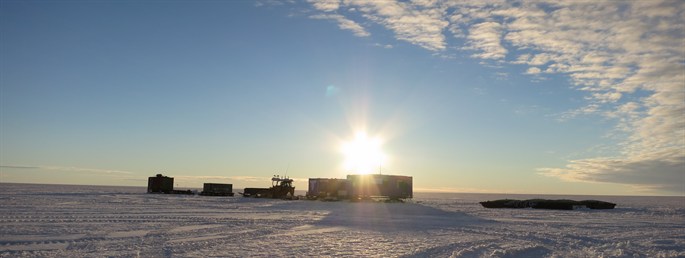Camp 2 – by Rob Lambert

Since we arrived at the ice edge a couple of weeks ago, our work here has concentrated on getting all of our kit out from the various ship’s holds and hidey holes and onto the ice. As equipment was craned ashore it was whisked away by our myriad of helpers, scurrying busily like so many oompah loompahs (though considerably more attractive), and deposited at one of three main work sites. Firstly, there was the unloading point at the foot of the ice shelf immediately next to the ship. Secondly, we had a site a few hundred yards up the ice ramp: here we plonked the cabooses where we could live and work on them away from the hustle, bustle, and potential instability of the very edge of the ice. And thirdly, we had a large work area a couple of kilometres away, beyond the top of the ramp and on the huge expanse of the ice shelf itself. This provided the flat ground and necessary space for all the fuel scoots and other heavy equipment to be stored, laid out in lines perpendicular to the prevailing winds to lessen the effects of drifting snow. It’s been interesting trying to work across all three sites and easy to lose track of what was where, but today we moved house: we brought the cabooses and all the rest of our mobile workshop – as Ian said, “the most stunning workshop in the world” – up the ramp to join all the rest of the equipment at one single encampment. Camp 2.
The move itself went very well. Spencer reversed the Cat and science caboose up to the storage sledge, hitched up, and pulled smoothly up the ramp. The rest of us followed on skidoos as light snow fell, while Ran broke out the skis and glided along behind. En route, towards the top of the ramp we encountered a new crack in the ice, scything its way across our path as the ice below continues its inexorable journey to the ocean. The crack was deep, but safe enough to cross, and further evidence of the living, breathing geography surrounding us. As if another reminder were needed, from the comparative safety of our new camp a short while later we listened in awe while an immense rumbling, booming sound floated across the ice to us for a full minute; not thunder, but the unmistakable sound of the ice cliffs below disintegrating into the sea.
“As Hannibal had his elephants, we have our Cats”
Now, at camp 2, for the first time since the expedition was conceived we’ve been confronted with the stark sight of all our equipment – and nothing more – in a single place. Seeing really is believing. There’s quite a bit of it and, just as it is too late for any of us six to turn around and go home, so we can’t send any unwanted kit back now. It must all move with us over the next four thousand kilometres, to the far edge of the continent. There’s no doubt that Ran faces an epic personal challenge in attempting to cross those many miles on foot. But for the rest of us, and for the team on SA Agulhas and back home, this journey also poses an engineering and logistical challenge of formidable proportions. As Hannibal had his elephants, we have our Cats, and they must be fed and watered. You should see Spence and Richmond’s toolbox.
We’ll spend a couple of days here at camp 2, trying to work out where to put it all (Brian’s head is becoming ever more well-scratched), putting the final touches to the cabooses, and preparing the vehicles for their first big test. In a few days we’ll set off, heading south through the mountains and up to the Antarctic plateau 3,000 metres higher. There we’ll leave a depot of food, fuel and supplies, before coming back to the coast to begin the traverse proper as winter begins in late March.
Meanwhile, we’ll spend tonight in unfamiliar surroundings. No longer is our view of the comforting sea – our last link with home – behind us, or of the yawning chasm of an icy crevasse – our neighbour for the last two weeks – to our side, or of the ice ramp – our first campsite here – ahead of us. Instead, this evening we have nothing but a flat, white horizon in every direction. It’s a view we’ll have to get used to…

Comments are closed